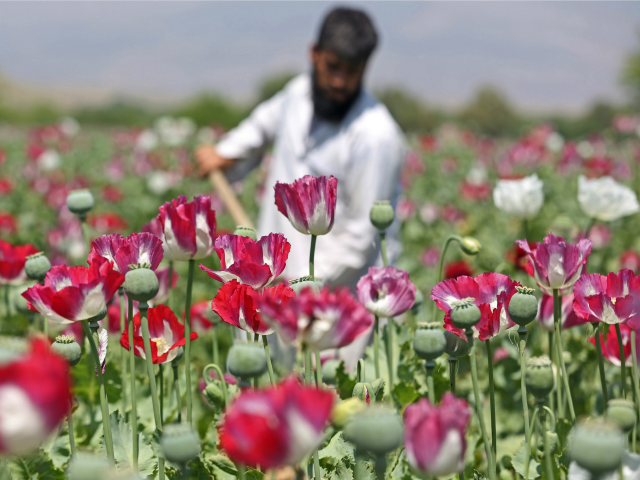According to a new study from Iran’s Drug Control Organization, the number of people regularly consuming drugs has grown from 1.3 million six years ago to at least 2.8 million today. The vast majority of these drug users favor opium, which flows in from Afghanistan.
The BBC argues that America’s overthrow of the Taliban in 2001 paved the way for a surge in Afghan opium production, to the point that it now produces about 90 percent of the world’s supply. Iran is “a major transit point for Afghan-produced opiates heading to Europe.”
However, the UK Independent quotes U.N. researchers who say opium exports from Afghanistan have surged over the past year because the Taliban is back in power, controlling almost 40 percent of the country. The Taliban uses opium as a cash crop to fund its military activities, and as a source of both jobs and money to win allegiance from rural Afghans. Good weather is also said to have boosted opium production.
According to the Iranian study, about 67 percent of Iranian drug users prefer opium and its derivatives, followed by 12 percent for marijuana, and 8 percent for methamphetamines.
The BBC quotes an Iranian official who suspects the number of drug users may actually be higher than the 2.8 million figure offered by the latest survey because respondents might have been reluctant to mention relatives who are addicts. The total population of Iran is about 80 million.
The Independent notes the United Nations declared that Iran has one of the worst drug addiction crises in the world last year. “Economic stagnation and high unemployment – the lingering result of years of US nuclear sanctions – are widely thought to be to blame,” the Independent writes.
Alarm bells have been ringing in Iran for a long time. In 2013, The Economist reported on a surge of Iranian youth getting hooked on hard drugs. Extremely high youth unemployment and inflation due to sanctions – which should be universally blamed on Iran’s government and its quest for illegal weapons, not the U.S. and other nations that were forced to impose sanctions – were seen as driving factors, along with the ready availability of Afghan opium.
Another factor given little attention outside that four-year-old Economist piece is the strict taboo against drinking alcohol, which turns Iranians seeking release to more dangerous substances. In years past, homemade crystal meth was a strong contender for the favor of addicts, among both unemployed young men and middle-aged women who wanted chemical help to keep their thin figures. Meth, which is known as shishe (“glass”) in Iran, was so popular that Iranians were allegedly buying do-it-yourself courses to run meth labs at home.
Opium is the undisputed champion of Iranian drugs now, largely smoked in pipes. Not only is it readily available from Afghanistan, but opium enjoys a certain degree of social acceptance in some quarters of Iran, due to customs that date back to the Persian Empire. Some Iranian minorities are reluctant to cooperate with the government on drug investigations because they fear such investigations will be used as excuses to crack down on political dissidents.
Despite the unsurprisingly severe penalties for dealing drugs in Iran, drug abuse became so prevalent that by 2014, reporters found brazen open-air drug markets flourishing in impoverished southern Tehran.
“Smoking opium is a tradition,” Lara Marlowe of the Irish Times reported in 2014. “In Kerman, for example, guests are greeted with an opium pipe. Drug use affects all strata of Iranian society. I once interviewed an ageing intellectual whose friends gathered every day in his beautiful north Tehran home to smoke opium.” One of the addicts she interviewed said her first “gift” of heroin was tucked into a bouquet of flowers by a suitor when she was 15 years old.
Marlowe’s report noted that Tehran claims to spend a billion dollars a year on drug interdiction and prevention, and almost two-thirds of Iran’s executions since 2011 have been drug traffickers. However, the government is quite lenient with drug users, to the point of routine catch-and-release roundups in the most notorious locations.
By December 2016, the L.A. Times found opium smokers everywhere in Tehran: “They loiter on pedestrian bridges, puffing on pipes. They squat behind bushes and palm trees in leafy parks to get their fix. Even doctors and nurses are users.”
While earlier reports tended to portray drug addiction as largely a problem of the poor and unemployed in Tehran, contemporary accounts stress how widely addiction has spread across every stratum of society. “No walk of society is immune. Even the sons of Islamic clerics are patients in our clinics,” the head doctor at a Tehran rehab clinic told the L.A. Times.
A secondary problem mentioned by the Times is that methadone is dispensed in large quantities to help wean addicts away from opium and the addicts are now hoarding and selling methadone pills on a thriving black market. Another thriving industry is privately operated rehabilitation camps, where addicts who cannot be accommodated by the government-run rehab system are warehoused with little access to effective treatment.
Almost every story about Iran’s drug problem blames harsh economic conditions brought about by economic sanctions, but those sanctions are largely gone now.
The Economist story from 2013 reported optimism in Iran that incoming President Hassan Rouhani’s policies would produce an economic revival that reduced drug abuse, but four years later it’s worse than ever.
Iran’s efforts to control the Afghanistan border have resulted in hundreds of dead border guards and not much reduction in the opium supply. The measures Tehran has taken against drug dealers are so harsh that some international humanitarian organizations refuse to cooperate with the Iranian government on its drug crisis. Fresh thinking is vitally needed, but that is always a scarce resource in the Islamic Republic.

COMMENTS
Please let us know if you're having issues with commenting.